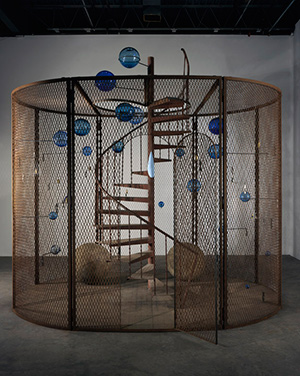
Cell (The Last Climb)
Louise Bourgeois
Cell (The Last Climb), 2008
Steel, glass, rubber, thread, and wood, 384.8 x 400.1 x 299.7 cm
National Gallery of Canada, Ottawa
Photo: Christopher Burke, © The Easton Foundation/VEGAP, Madrid
“The objects in the Cells are fragile. The fact that you cannot enter them in most cases had to do with the fragility of the interior. This is a problem when they are shown publicly. I would like people to enter the Cells.” —Louise Bourgeois[1]
Louise Bourgeois (b. 1911, Paris; d. 2010, New York) was a French American artist who lived almost a hundred years. She worked on her sculptures, paintings, drawings, prints, and performances almost until the day she died. Two years before she passed away Bourgeois created the artwork Cell (The Last Climb) (2008), the last Cell of her series that ran like leitmotif through her long creative life. The Cells are a series of installations made out of a mixture of made and found objects, including doors or other structures the artist collected from the neighborhood. These installations are cluttered with memories from Bourgeois’s personal life, like fears she carried from her childhood.[2] For the artist, the word “cell” had many connotations, from the biological cell of a living organism to the isolation of a prison cell or monastic chamber.[3]
In late 2005 Bourgeois had to move out of her Brooklyn studio where she had worked for 25 years because buildings on her block were being torn down.[4]But before moving she had the studio’s spiral staircase removed and kept it for future use.[5] The staircase was an integral part of her life—she had it custom made in the 1980s, and climbed up and down them every day while making her art.
With her staircase as the main protagonist, Bourgeois created Cell (The Last Climb). In her piece, the staircase is surrounded by wire-mesh cage where inside and outside become one. A narrow arched door in the wall of the cage stands open, inviting the viewer to enter.
Bourgeois placed a number of objects charged with symbolic meaning in the interior of Cell (The Last Climb). On the floor, two large wooden spheres symbolize her parents. All around the stairs are celestial blue glass spheres that appear to rise toward the sky. The higher their position, the larger the glass spheres are, like bubbles in a liquid that expand as they rise.[6] Suspended in the center is an elongated blue teardrop that represents the artist. The teardrop is punctured by threaded needles, which lead to spools positioned around the metal cage: ties to her family who ran a tapestry restoration workshop and gallery, where the artist assisted from an early age. With Cell (The Last Climb), and close to the end of her life, Bourgeois seemed to create a more optimistic installation, leaving behind her fears of mortality and imprisonment: She was at peace with herself.[7]
1. http://www.db-artmag.com/archiv/2004/e/9/1/293-3.html
2. http://arttattler.com/archivebourgeois.html
3. http://www.collectortribune.com/2015/08/04/louise-bourgeois-structures-of-existence-the-cells-at-garage-museum-moscow/
4. http://www.artslant.com/ny/articles/show/2707
5. http://www.ngcmagazine.ca/exhibitions/do-undo-redo-mantra-of-a-monolithic-artist
6. Lorz and Fowle, p. 91.
7. Ibid., p. 93.
Preguntas
Show: Cell (The Last Climb) (2008)
Describe this artwork as thoroughly as possible. What do you see? If you had to explain the piece to someone who cannot see it, how would you describe it? Have you ever seen a staircase similar to the one in the artwork? Where? What do the spheres remind you of?
Imagine how you would feel if you walked inside Cell (The Last Climb). Explain what your emotions would be. Would you climb the staircase? If you could add sound to the sculpture, what would you hear inside it?
Shapes and colors in this work are thought to be symbolic. The color blue represents peace, meditation, and escape for the artist.[8] Discuss the meaning of color for you; do particular colors have particular meanings and why might that be?
The shape of a spiral, like the staircase, is also very important in this work. For Bourgeois, a spiral is an attempt to control chaos but it is always in danger of unraveling and spiraling out of control.[9] What possible other meanings can you think of for a spiral?
8. Christiane Meyer-Thoss, Louise Bourgeois: Designing for Free Fall (Zurich: Ammann Verlag, 1992), p. 222.
9. http://www.tate.org.uk/download/file/fid/37633
